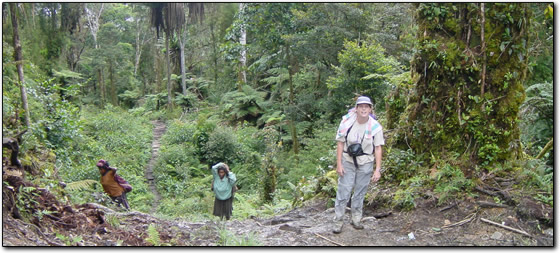
Wamarek to Wamena
The next day we walked up the valley to Tangma, a large missionary village, then continued on to Seima. We were happy to have stayed in Wamarek, as Tangma was a modern-looking village with many “Western” wooden clapboard houses. After Tangma the trail turned up a steep incline. It was not even visible from below. We walked along a narrow path with a precipitous drop-off before emerging on a flattened, mountainous shoulder. A group of Italian tourists was resting. Dressed in spotless outdoor wear, much of it still brand-new, their shoes were even white! We didn’t realize it before our arrival, but tourism is a big industry in this part of Papua. Although it does provide jobs for locals, we wondered what kind of impression the Papuans would get from this kind of group. They certainly weren’t going to eat sweet potatoes for dinner, nor were they likely to interact much with their hosts. All of their cooking and carrying was done for them. In some groups, including this one, there were as many as two porters per tourist. Imagine walking into a village with a group of 10 tourists, along with a support staff of 25 including porters, guides and cooks. What kind of pressure would this put on the local infrastructure, and what kind of effect would it have on the local economy? We preferred to take one guide and carry our own bags, out of respect for the villages we passed through as well as for the challenge of the trek.
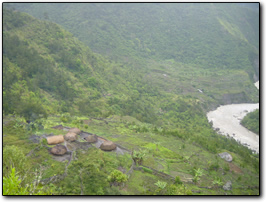 |
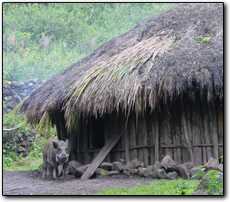 |
Later along the trail we met three independent tourists, including one American, named Dan. Fed up with the rapacious guides in Wamena, they had bought food for their trek, set out from town and found a guide along the way. It helped that one of them could speak Indonesian. We arrived later that day in Seima, a small town across the river from Kurima. After a few days without bathing it was time to take advantage of the stream rushing through the village for a bath. Eric picked his way down a muddy slope to the men’s bathing area, bracing himself for the cold water. There was no privacy, though. Two other bathing men stopped everything to watch, and there were plenty of spying children up the slope. That night we decided to cook with local ingredients. We bought a couple of sweet potatoes and carrots from our hosts. Cutting them into small pieces was hard work, almost like splitting wood. Frying some Indian spices in oil, then adding potatoes, a few carrots and some succulent green onions, we made a big pot of sweet potato curry. After eating our fill, we gave the rest to the locals. The children especially liked the thick curry sauce – they licked their plates clean. Afterwards, one of the boys politely volunteered to wash the pot and plates.
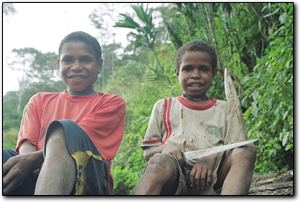 |
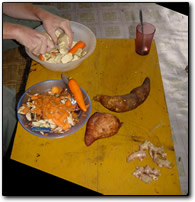 |
Back in Wamena, we had a few days to rest before the Baliem festival started. We decided to drop by the police post at the airport to check if we could visit Danau Habbema, a high mountain lake known for its interesting plant life. After showing the officer our surat jalan, and asking if the area was open, he excused himself for a moment. When he came back he said that we could not go by ourselves, but if we wanted an escort from the army, he could arrange it. Were there problems there? Was the OPM in the area? Instead of answering, he just looked at us strangely. A guide in town later told us that the OPM was definitely in the area, but if we really wanted to, he could take us overland, bypassing the police checkpoints, to a vantage point where we could see the lake. Not wanting to go looking for trouble, we decided to go somewhere else.
